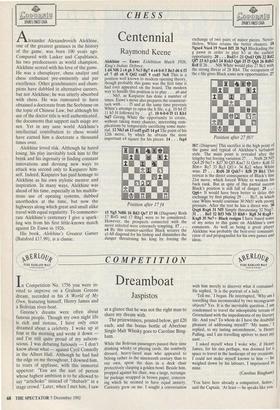Centennial
Raymond Keene
Alexander Alexandrovich Alekhine, one of the greatest geniuses in the history of the game, was born 100 years ago. Compared with Lasker and Capablanca, his two predecessors as world champion, Alekhine scored with his love of the game. He was a chessplayer, chess analyst and chess enthusiast pre-eminently and par excellence. Other grandmasters and cham- pions have dabbled in alternative careers, but not Alekhine; he was utterly absorbed with chess. He was rumoured to have obtained a doctorate from the Sorbonne on the topic of Chinese Law, but although his use of the doctor title is well authenticated, the documents that support such usage are not. Yet in any sane world Alekhine's intellectual contribution to chess would have earned him a doctorate a thousand times over.
Alekhine loved risk. Although he hated losing, his play inevitably took him to the brink and his ingenuity in finding constant innovations and devising new ways to attack was second only to Kasparov him- self. Indeed, Kasparov has paid homage to Alekhine as his own stylistic mentor and inspiration. In many ways, Alekhine was ahead of his time, especially in his multifa- rious use of opening systems, dubbed unorthodox at the time, but now the highways along which great and small alike travel with equal regularity. To commemo- rate Alekhine's centenary I give a spark- ling win from his first little-known match against Dr Euwe in 1926.
His book, Alekhine's Greatest Games (Batsford £17.99), is a classic. Alekhine — Euwe: Exhibition Match 1926; King's Indian Defence.
1 d4 Nf6 2 c4 g6 3 Nc3 Bg7 4 e4 0-0 5 Be3 d6 6 f3 e5 7 d5 c6 8 Qd2 cxd5 9 cxd5 Ne8 This is a position well known to modern opening theory, though probably this game was the first time it had ever appeared on the board. The modern way to handle this position is to play. . . a6 and . . . Nh5, as Kasparov has done a number of times. Euwe's move also prepares the counterat- tack with . . . f5 and at the same time prevents White's attempt to open the h file, e.g. 10 h4 f5 11 h5 f4 followed by. . . g5. 10 0-0-0 f5 11 Kb! Nd7 Giving White the opportunity to create, without taking many chances, interesting com- plications by temporarily sacrificing some mate- rial. 12 Nh3 a6 13 exf5 gxf5 14 g4 The point of his 12th move, by which he obtains the most important e4 square for his pieces. 14. . . fxg4 Position after 17f4 15 Ng5 Ndf6 16 Bd3 Qe7 17 f4 (Diagram) Both 17 Rcfl and 17 Rhgl were to be considered. However, the prospects connected with the move selected were extremely tempting. 17. . . e4 By this counter-sacrifice Black secures the al-h8 diagonal for his bishop and diminishes the danger threatening his king by forcing the exchange of two pairs of minor pieces. Never- theless, White retains the better chances. 10 Ngxe4 Nxe4 19 Nxe4 Bf5 20 Ng3 Blockading the g pawn in order to play h3 at the earliest opportunity. 20. . . Bxd3+ 21 Qxd3 Qf6 22 Rd2 Qf7 23 h3 gxh3 24 Rxh3 Qg6 25 f5 Qg4 26 Rdh2 Rc8 If 26. . . Nf6 White would play 27 Bc1 with the strong threat of 28 Rh4. The occupation of the c file gives Black some new opportunities. 27 Position after 27f6!!
16!! (Diagram) This sacrifice is the high point of the game and typical of Alekhine's turbulent style. The main point is revealed after the lengthy but forcing variation 27. . . Nxf6 28 Nf5 Qc4 29 Ne7+ Kf7 30 Qf5 Kxe7 31 Qe6+ Kd8 32 Bb6+ Rc7 33 Rc3 Qfl + 34 Kc2 when White wins. 27 . . . Rxf6 28 Qxh7+ Kf8 29 Rh! This retreat is the direct consequence of Black's fine 21st move, which forced White to weaken his back rank. But in spite of this partial success Black's position is still full of danger. 29 . ..• Qg6+ It would have been better to delay this exchange by first playing 29 . . . Rc7, in which case White would continue 30 Nh5! with strong pressure. After the text he has a direct win. 30 Qxg6 Rxg6 31 Nf5 Simply threatening 32 Nxg7. 3!. . . Be5 32 R13 Nf6 33 Rh8+ Rg8 34 Rxg8+ Kxg8 35 Ne7+ Black resigns I have based some of my notes to this game on Alekhine's own comments. As well as being a great player Alekhine was probably the best-ever communi- cator of and propagandist for his own games and ideas.










































































 Previous page
Previous page